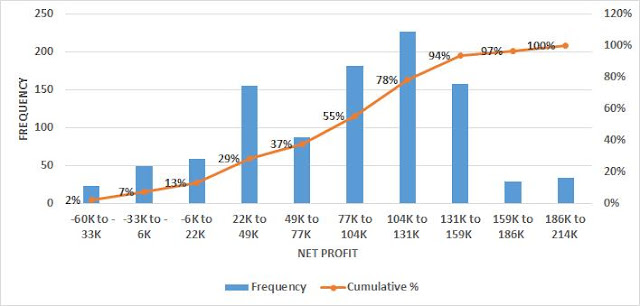OBJECTIVE
Determine
probable outcomes.
DESCRIPTION
In deterministic models we predict
events in a simple linear system and we assume that the initial conditions do not
change. Besides, the same initial conditions will give the same results. However,
the world is more complicated and events are usually determined by a complex
interrelation of different variables, some of which are difficult or almost
impossible to estimate. Monte Carlo simulations solve this problem by using
probability distributions for each input variable and then running several
simulations to produce probable outcomes. We can say that this model allows the
prediction of an outcome without conducting many expensive experiments.
The steps
for performing a Monte Carlo simulation are:
- - Define the mathematical formula for the outcome;
- - Identify the probability distributions of the input variables and define their parameters;
- - Run the simulations;
- - Analyze and optimize.
Monte Carlo Simulation Output
Input and Output Variables
The first
step in a Monte Carlos simulation is to define the output, that is to say to identify
the variable that we want to predict, for example “profits.” Then we should
identify the input variables on which “profits” depend. Some of them may be
certain; for example, we can have a fixed cost with a specific value, but
usually they are uncertain. For each of the uncertain variables, we need to identify
a specific probability distribution to use for the simulation. Examples of
distribution are:
- - Discrete distribution: we define the probability of a finite number of values;
- - Uniform distribution: each variable value has similar probabilities (for example, when throwing a die, each number has a 1/6 probability);
- - Bernoulli distribution: we have only two alternative and exclusive outcomes (0 or 1);
- - Normal distribution: the central values are the most probable ones (defined by the mean and standard deviation);
- - Triangular distribution: we have a most probable value and a lower and an upper limit;
- - Other distributions: exponential, logarithmic, binomial, beta, etc.
Having identified
the distribution, we can use a chi-square test (see 48. CHI-SQUARE) to check whether the data fit the chosen
distribution. An alternative would be to conduct a Korm–Smirnov test.
In this
phase we also write the mathematical formula by which the outcome is defined,
for example:
Profits = (Price – Variable cost) * Units –
Fixed Costs
The
simulation is then performed repeating the input variables (with each specific
probability distribution) hundreds or thousands of times to obtain a
distribution of probable results.
Analysis and Optimization
Once the
range of probable results has been obtained, depending on the objective, we use
indicators such as the minimum value, maximum value, average, standard
deviation, and so on. In general we usually compare:
- - Expected value: the mean of all the outputs with its confidence intervals;
- - Risk: in the proposed example it is the probability of negative profits (% of outputs < 0), but we can also choose a specific value.
It is also
possible to compare different simulations with different input variables’
values or distributions. To compare them, we should calculate the confidence
intervals of both expected values and risks. If the range between the
confidence intervals does not overlap, we can infer that one scenario is better
or worse than the other one.
If the objective
is to use the results for a business plan or in risk analysis, we can stop
here, but if we want to optimize the outcomes, a sensitivity analysis is
needed. In this kind of analysis, we measure the “importance” of each input and
may decide to act on the most influential ones. Usually the correlation
coefficient between each input and the output is used, but different techniques
can be adopted.
TEMPLATE
Discount code -40%: BLOG_ANALYTICS_MODELS

No comments:
Post a Comment